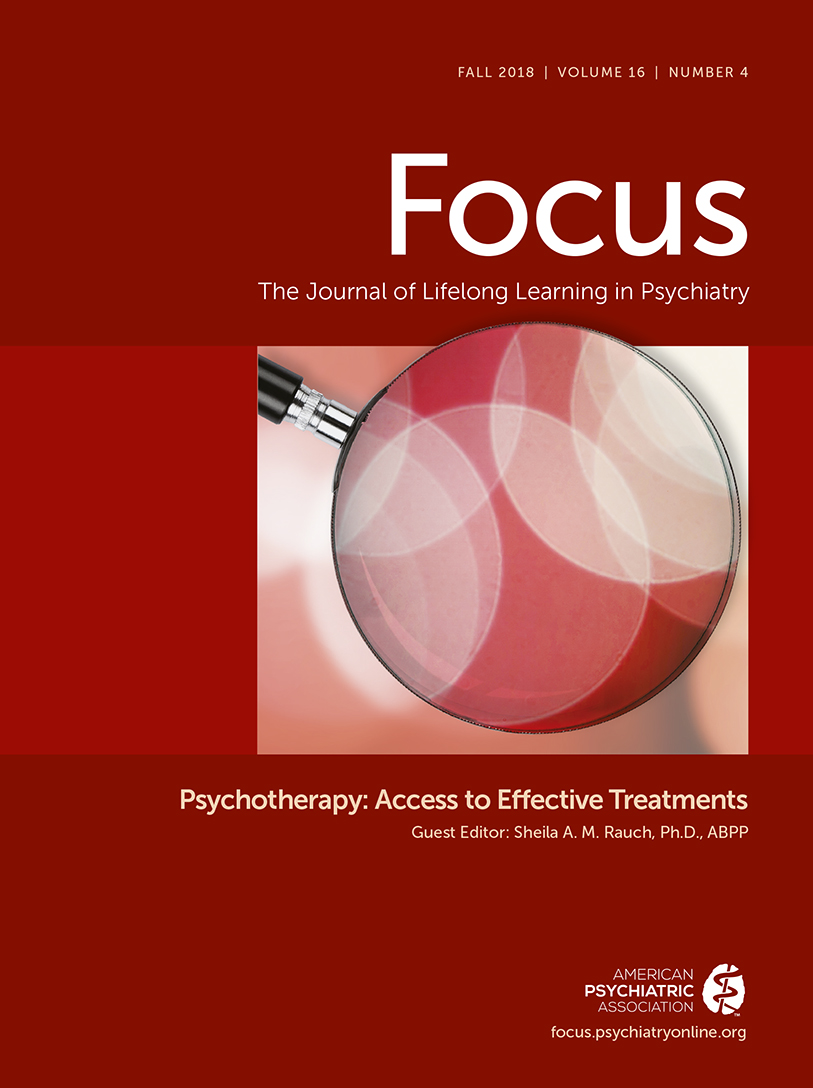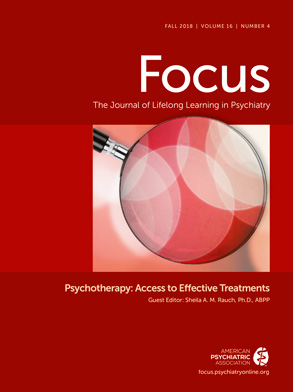Computer Therapy for the Anxiety and Depression Disorders Is Effective, Acceptable and Practical Health Care: An Updated Meta-Analysis
Andrews G, Basu A, Cuijpers P, et al.
J Anxiety Disord 2018 Apr; 55:70–78
BACKGROUND: A 2010 meta-analysis of internet-delivered CBT (iCBT) RCTs argued 'computer therapy for the anxiety and depressive disorders was effective, acceptable and practical health care' without data on effectiveness or practicality in routine practice.
METHODS: Databases, reviews and meta-analyses were searched for randomized controlled trials of cCBT or iCBT versus a control group (care as usual, waitlist, information control, psychological placebo, pill placebo, etc.) in people who met diagnostic criteria for major depression, panic disorder, social anxiety disorder or generalized anxiety disorder. Number randomized, superiority of treatment versus control (Hedges'g) on primary outcome measure, length of follow-up, follow up outcome, patient adherence and satisfaction/harm were extracted; risk of bias was assessed. A search for studies on effectiveness of iCBT in clinical practice was conducted.
RESULTS: 64 trials were identified. The mean effect size (efficacy) was g = 0.80 (NNT 2.34), and benefit was evident across all four disorders. Improvement was maintained at follow-with good acceptability. Research probity was good, and bias risk low. In addition, nine studies comparing iCBT with traditional face-to-face CBT and three comparing iCBT with bibliotherapy were identified. All three modes of treatment delivery appeared equally beneficial. The results of effectiveness studies were congruent with the results of the efficacy trials.
LIMITATIONS: Studies variably measured changes in quality of life and disability, and the lack of comparisons with medications weakens the field.
CONCLUSIONS: The conclusions drawn in the original meta-analysis are now supported: iCBT for the anxiety and depressive disorders is effective, acceptable and practical healthcare.
Reprinted with permission from Elsevier.
A Non-Inferiority Trial of Prolonged Exposure for Posttraumatic Stress Disorder: In Person Versus Home-Based Telehealth
Acierno R, Knapp R, Tuerk P, et al.
Behav Res Ther 2017 Feb; 89:57–65
This is the first randomized controlled trial to evaluate noninferiority of Prolonged Exposure (PE) delivered via home-based telehealth (HBT) compared with standard in-person (IP) PE. One-hundred thirty two Veterans recruited from a Southeastern Veterans Affairs Medical Center and affiliated University who met criteria for posttraumatic stress disorder (PTSD) were randomized to receive PE via HBT or PE via IP. Results indicated that PE-HBT was noninferior to PE-IP in terms of reducing PTSD scores at posttreatment, 3 and 6 month follow-up. However, noninferiority hypotheses for depression were only supported at 6 month follow-up. HBT has great potential to reduce patient burden associated with receiving treatment in terms of travel time, travel cost, lost work, and stigma without sacrificing efficacy. These findings indicate that telehealth treatment delivered directly into patients' homes may dramatically increase the reach of this evidence-based therapy for PTSD without diminishing effectiveness.
Reprinted with permission from Elsevier.
Technology-Based Interventions for the Treatment and Recovery Management of Substance Use Disorders: A JSAT Special Issue
Marsch LA, Carroll KM, Kiluk B.D.
J Subst Abuse Treat 2014 Jan; 46(1):1-4
A growing line of research has highlighted the promising role that interactive web and mobile technologies may play in improving the effectiveness, cost-effectiveness, and reach of efforts to assess, prevent, treat, and support the recovery management of substance use disorders and other risk behavior. Manuscripts in this special issue of the Journal of Substance Abuse Treatment focus on the application of technology to the delivery of interventions for the treatment and recovery management of substance use disorders. These manuscripts are intended to highlight the diversity and current state of the science of empirically-supported innovations in this area of intervention delivery. The included manuscripts range from experimental evaluations of a variety of types of technology-based interventions (brief interventions, behavior therapy, medication adherence tools, and HIV prevention interventions) and technology platforms (mobile, Web, videoconferencing, and telephone-based interactive voice response), for an array of populations (adults, adolescents, criminal justice populations, and postpartum women), in a number of different settings (addiction specialty treatment programs, schools, emergency rooms, and criminal justice settings). They additionally reflect a variety of experimental research designs, including those focused on the design, development, and clinical evaluation of these technology-based therapeutic tools, as well as research focused on models for their successful implementation and sustained use.
Reprinted with permission from Elsevier.
The Effects of Cognitive-Behavior Therapy for Depression on Repetitive Negative Thinking: A Meta-Analysis
Spinhoven P, Klein N, Kennis M, Cramer AOJ, et al.
Behav Res Ther 2018 Jul; 106:71–85
It is not clear if treatments for depression targeting repetitive negative thinking (RNT: rumination, worry and content-independent perseverative thinking) have a specific effect on RNT resulting in better outcomes than treatments that do not specifically target rumination. We conducted a systematic search of PsycINFO, PubMed, Embase and the Cochrane library for randomized trials in adolescents, adults and older adults comparing CBT treatments for (previous) depression with control groups or with other treatments and reporting outcomes on RNT. Inclusion criteria were met by 36 studies with a total of 3307 participants. At posttest we found a medium-sized effect of any treatment compared with control groups on RNT (g = 0.48; 95% CI: 0.37–0.59). Rumination-focused CBT: g = 0.76, <0.01; Cognitive Control Training: g = 0.62, p < 0.01; CBT: g = 0.57, p < 0.01; Concreteness training: g = 0.53, p < 0.05; and Mindfulness-based Cognitive Therapy: g = 0.42, p < 0.05 had medium sized and significantly larger effect sizes than other types of treatment (i.e. antidepressant medication, light therapy, engagement counseling, life review, expressive writing, yoga) (g = 0.14) compared with control groups. Effects on RNT at posttest were strongly associated with the effects on depression severity and this association was only significant in RNT-focused CBT. Our results suggest that in particular RNT-focused CBT may have a more pronounced effect on RNT than other types of interventions. Further mediation and mechanistic studies to test the predictive value of reductions in RNT following RNT-focused CBT for subsequent depression outcomes are called for.
Reprinted with permission from Elsevier.
Mobile Health (mHealth) Versus Clinic-Based Group Intervention for People With Serious Mental Illness: A Randomized Controlled Trial
Ben-Zeev D, Brian RM, Jonathan G, Razzano L, et al.
Psychiatr Serv 2018 May 25: doi.org/10.1176/appi.ps.201800063
OBJECTIVE: mHealth approaches that use mobile phones to deliver interventions can help improve access to care for people with serious mental illness. The goal was to evaluate how mHealth performs against more traditional treatment.
METHODS: A three-month randomized controlled trial was conducted of a smartphone delivered intervention (FOCUS) versus a clinic-based group intervention (Wellness Recovery Action Plan [WRAP]). Participants were 163 clients, mostly from racial minority groups and with long-term, serious mental illness (schizophrenia or schizoaffective disorder, 49%; bipolar disorder, 28%; and major depressive disorder, 23%). Outcomes were engagement throughout the intervention; satisfaction posttreatment (three months); and improvement in clinical symptoms, recovery, and quality of life (assessed at baseline, posttreatment, and six months).
RESULTS: Participants assigned to FOCUS were more likely than those assigned to WRAP to commence treatment (90% versus 58%) and remain fully engaged in eight weeks of care (56% versus 40%). Satisfaction ratings were comparably high for both interventions. Participants in both groups improved significantly and did not differ in clinical outcomes, including general psychopathology and depression. Significant improvements in recovery were seen for the WRAP group posttreatment, and significant improvements in recovery and quality of life were seen for the FOCUS group at six months.
CONCLUSIONS: Both interventions produced significant gains among clients with serious and persistent mental illnesses who were mostly from racial minority groups. The mHealth intervention showed superior patient engagement and produced patient satisfaction and clinical and recovery outcomes that were comparable to those from a widely used clinic-based group intervention for illness management.
Reprinted with permission from American Psychiatric Association Publishing.
Functional Connectivity of the Subcallosal Cingulate Cortex and Differential Outcomes to Treatment With Cognitive-Behavioral Therapy or Antidepressant Medication for Major Depressive Disorder
Dunlop BW, Rajendra JK, Craighead WE, et al.
Am J Psychiatry 2017 Jun 1; 174(6):533–545
OBJECTIVE: The purpose of this article was to inform the first-line treatment choice between cognitive-behavioral therapy (CBT) or an antidepressant medication for treatment-naive adults with major depressive disorder by defining a neuroimaging biomarker that differentially identifies the outcomes of remission and treatment failure to these interventions.
METHOD: Functional MRI resting-state functional connectivity analyses using a bilateral subcallosal cingulate cortex (SCC) seed was applied to 122 patients from the Prediction of Remission to Individual and Combined Treatments (PReDICT) study who completed 12 weeks of randomized treatment with CBT or antidepressant medication. Of the 122 participants, 58 achieved remission (Hamilton Depression Rating Scale [HAM-D] score≤7 at weeks 10 and 12), and 24 had treatment failure (<30% decrease from baseline in HAM-D score). A 2×2 analysis of variance using voxel-wise subsampling permutation tests compared the interaction of treatment and outcome. Receiver operating characteristic curves constructed using brain connectivity measures were used to determine possible classification rates for differential treatment outcomes.
RESULTS: The resting-state functional connectivity of the following three regions with the SCC was differentially associated with outcomes of remission and treatment failure to CBT and antidepressant medication and survived application of the subsample permutation tests: the left anterior ventrolateral prefrontal cortex/insula, the dorsal midbrain, and the left ventromedial prefrontal cortex. Using the summed SCC functional connectivity scores for these three regions, overall classification rates of 72%−78% for remission and 75%−89% for treatment failure was demonstrated. Positive summed functional connectivity was associated with remission with CBT and treatment failure with medication, whereas negative summed functional connectivity scores were associated with remission to medication and treatment failure with CBT.
CONCLUSIONS: Imaging-based depression subtypes defined using resting-state functional connectivity differentially identified an individual's probability of remission or treatment failure with first-line treatment options for major depression. This biomarker should be explored in future research through prospective testing and as a component of multivariate treatment prediction models.
Reprinted with permission from American Psychiatric Association Publishing.
Cognitive Behavioral Interventions for Alcohol and Drug Use Disorders: Through the Stage Model and Back Again
Carroll KM, Kiluk B.D.
Psychol Addict Behav 2017 Dec; 31(8):847–861.
Cognitive-behavioral therapy (CBT) approaches have among the highest level of empirical support for the treatment of drug and alcohol use disorders. As Psychology of Addictive Behaviors marks its 30th anniversary, we review the evolution of CBT for the addictions through the lens of the Stage Model of Behavioral Therapies Development. The large evidence base from Stage II randomized clinical trials indicates a modest effect size with evidence of relatively durable effects, but limited diffusion in clinical practice, as is the case for most empirically validated approaches for mental health and addictive disorders. Technology may provide a means for CBT interventions to circumvent the “implementation cliff” in Stages III-V by offering a flexible, low-cost, standardized means of disseminating CBT in a range of novel settings and populations. Moreover, returning to Stage I to reconnect clinical applications of CBT to recent developments in cognitive science and neuroscience holds great promise for accelerating understanding of mechanisms of action. It is critical that CBT not be considered as a static intervention, but rather 1 that constantly evolves and is refined through the stage model until the field achieves a maximally powerful intervention that addresses core features of the addictions.
Reprinted with permission from the American Psychological Association.

